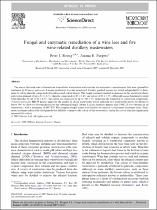 ResearchSpace
ResearchSpace
Fungal and enzymatic remediation of a wine lees and five wine-related distillery wastewaters
JavaScript is disabled for your browser. Some features of this site may not work without it.
- ResearchSpace
- →
- Research Publications/Outputs
- →
- Journal Articles
- →
- View Item
| dc.contributor.author |
Strong, PJ

|
|
| dc.contributor.author |
Burgess, JE

|
|
| dc.date.accessioned | 2009-06-17T09:23:27Z | |
| dc.date.available | 2009-06-17T09:23:27Z | |
| dc.date.issued | 2008-09 | |
| dc.identifier.citation | Strong, PJ and Burgess, JE. 2008. Fungal and enzymatic remediation of a wine lees and five wine-related distillery wastewaters. Bioresource Technology, Vol. (2008), pp 9 | en |
| dc.identifier.issn | 0960-8524 | |
| dc.identifier.uri | http://hdl.handle.net/10204/3432 | |
| dc.description | Copyright Elsevier, 2008. This is the post print version of the work. It is posted here by permission of Elsevier for personal use, not for redistribution | en |
| dc.description.abstract | The aim of this work was to characterise wine-related wastewaters and ascertain the wastewater concentrations that were optimal for treatment by Trametes pubescens. Laccase production was also monitored. Crudely purified laccase was tested independently to determine its role in phenolic compounds degradation and colour change. The fungal treatment resulted in decreases in the wastewater chemical oxygen demand of up to 83 ± 2.1%, phenolic compounds of 87 ± 1.6% and colour of 88 ± 4.7%. Although laccase treatment lowered total phenolics by up to 61 ± 0.5%, the colour was increased by up to 160 ± 5%, indicating the formation of colour-rich compounds. Trametes pubescens MB 89 greatly improved the quality of all six wastewaters tested, although two wastewaters had to be diluted to below 50% to allow for bioremediation by the submerged fungal culture. Laccase synthesis greater than 1500 U/l was obtained in all wastewaters, with a maximum of 8997 U/l. The complete fungal system was found to be superior to enzymatic treatment alone. Enzymatic treatment reduced the total phenols but did little to improve the colour of the wastewaters, and in the case of wine lees significantly increased the colour | en |
| dc.language.iso | en | en |
| dc.publisher | Elsevier | en |
| dc.subject | Fungi | en |
| dc.subject | Enzymes | en |
| dc.subject | Wastewater | en |
| dc.subject | Trametes pubescens | en |
| dc.subject | Wine lees | en |
| dc.subject | Effluent | en |
| dc.subject | Laccase | en |
| dc.subject | Vinasse | en |
| dc.subject | Chemical oxygen demand | en |
| dc.subject | COD | en |
| dc.title | Fungal and enzymatic remediation of a wine lees and five wine-related distillery wastewaters | en |
| dc.type | Article | en |
| dc.identifier.apacitation | Strong, P., & Burgess, J. (2008). Fungal and enzymatic remediation of a wine lees and five wine-related distillery wastewaters. http://hdl.handle.net/10204/3432 | en_ZA |
| dc.identifier.chicagocitation | Strong, PJ, and JE Burgess "Fungal and enzymatic remediation of a wine lees and five wine-related distillery wastewaters." (2008) http://hdl.handle.net/10204/3432 | en_ZA |
| dc.identifier.vancouvercitation | Strong P, Burgess J. Fungal and enzymatic remediation of a wine lees and five wine-related distillery wastewaters. 2008; http://hdl.handle.net/10204/3432. | en_ZA |
| dc.identifier.ris | TY - Article AU - Strong, PJ AU - Burgess, JE AB - The aim of this work was to characterise wine-related wastewaters and ascertain the wastewater concentrations that were optimal for treatment by Trametes pubescens. Laccase production was also monitored. Crudely purified laccase was tested independently to determine its role in phenolic compounds degradation and colour change. The fungal treatment resulted in decreases in the wastewater chemical oxygen demand of up to 83 ± 2.1%, phenolic compounds of 87 ± 1.6% and colour of 88 ± 4.7%. Although laccase treatment lowered total phenolics by up to 61 ± 0.5%, the colour was increased by up to 160 ± 5%, indicating the formation of colour-rich compounds. Trametes pubescens MB 89 greatly improved the quality of all six wastewaters tested, although two wastewaters had to be diluted to below 50% to allow for bioremediation by the submerged fungal culture. Laccase synthesis greater than 1500 U/l was obtained in all wastewaters, with a maximum of 8997 U/l. The complete fungal system was found to be superior to enzymatic treatment alone. Enzymatic treatment reduced the total phenols but did little to improve the colour of the wastewaters, and in the case of wine lees significantly increased the colour DA - 2008-09 DB - ResearchSpace DP - CSIR KW - Fungi KW - Enzymes KW - Wastewater KW - Trametes pubescens KW - Wine lees KW - Effluent KW - Laccase KW - Vinasse KW - Chemical oxygen demand KW - COD LK - https://researchspace.csir.co.za PY - 2008 SM - 0960-8524 T1 - Fungal and enzymatic remediation of a wine lees and five wine-related distillery wastewaters TI - Fungal and enzymatic remediation of a wine lees and five wine-related distillery wastewaters UR - http://hdl.handle.net/10204/3432 ER - | en_ZA |





